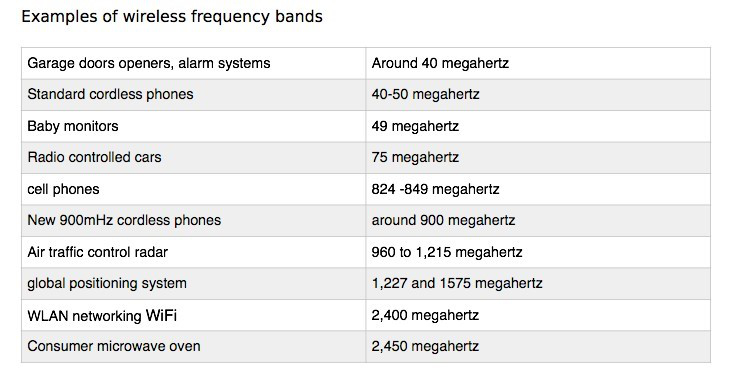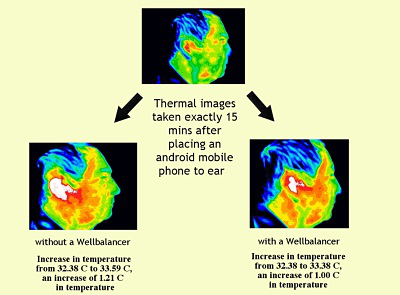Is radiation from your phone and tablet something you should be worried about?
Electronic devices – from phones to tablets to laptops – have made life so much easier that trying to contemplate an existence without them seems utterly absurd. Being able to transfer data wirelessly has allowed people and businesses to communicate more efficiently and cost effectively, not to mention giving us instant access to a wealth of information and knowledge that has greatly enhanced our everyday lives.
These wireless gadgets – from our garage doors to baby monitors, and, of course, cell phones and laptops – also produce electromagnetic fields, which means they emit a very real radiation (at different frequencies, which you can see in the table below). You may have read plenty of stories in the past discussing these effects, but it’s pretty likely you are still none the wiser when it comes to knowing whether they are actually harmful? It turns out just because we can’t see the radiation, doesn’t mean it isn’t there!
 Thankfully, you don’t have to take our word for it, as lots of research has been carried out in recent times. So before you start edging away from your mobile or laptop in fear, let’s take a look at what exactly the science has to say. For starters, studies have shown that there are two ways this radiation can present itself: a thermal effect and an oxidative stress effect.
Thankfully, you don’t have to take our word for it, as lots of research has been carried out in recent times. So before you start edging away from your mobile or laptop in fear, let’s take a look at what exactly the science has to say. For starters, studies have shown that there are two ways this radiation can present itself: a thermal effect and an oxidative stress effect.
The science
The thermal effect is as just as its name suggests, a product of heat. It can occur when an electronic device is in close proximity to our body, such as when we are talking on our mobile or have a laptop on our lap without anything in between. You will have noticed that after a certain amount of time, these devices heat up and this heat gets transferred to whatever’s closest, such as our heads, thighs and groin area.
There are, of course, various factors which can determine how much heat is being transferred, including the type of handset you have and the thickness of your skull (for children, there is an increased rate of transfer due to the nascent stages of their brain development and the relative thinness of their skulls).
Research has also shown that after a fifteen-minute phone call, devices can increase the temperature of our heads at an average of 1.21 degrees Celsius and that even an increase of just one degree Celsius, can reduce sperm count by a whopping 40%. When used consistently over one hour, it was found that the groin region had increased temperature by over 2 degrees Celsius, which is more than enough to affect motility (sperm movement) and damage the DNA.
Oxidative stress is a more complicated issue and requires a slightly more advanced understanding of human biology. Oxidative stress comes into effect when the body is put under duress due to an increased exposure to reactive oxygen species (ROS). In layman’s terms, reactive oxygen species are chemically reactive molecules which contain oxygen.
They are a byproduct of the body when metabolizing oxygen and have significant effects on homeostasis and other internal bodily functions. However, when there is exposure to serious amounts of ionizing radiation (like that released from our wireless electronic devices), this can result in an unhealthy increase in ROS. This causes oxidative stress, because the body isn’t equipped with enough antioxidants to counter the effect.
Research has shown that the negative consequences of this can be numerous, with it potentially leading to insomnia, muscoskeletal pain, negative effects on brain function, fatigue, and at even more dangerous levels, serious illnesses such as kidney disease, arthritis and neurodegenerative disorders.
For parents, hearing about this for the first time can be scary, not just for themselves, but for their children – who are now constantly surrounded by technology and gadgets. However, there are a few simple steps you can take to limit your family’s exposure.
What can you do?
– When it comes to thermal exposure, because its effects are proximity-based, the best solution is to keep a safe distance between yourself and the device; 15mm between your phone and your head is recommended, which is roughly the breadth of one of your fingers.
– Don’t put a laptop on your lap, especially when it’s charging, get a couple of telephone directories and rest the laptop on them instead.
– Since all manufacturers provide an earpiece, using that is a far safer method and if that’s not possible, use your speaker phone if the conversation isn’t a private one. When you’re not using the phone, try to store it in a non-metal holder at least 15mm away from the body, especially your chest and groin region.
– For the reduction of oxidative distress, you’ll want to reduce the level of ionizing radiation throughout your household. The simplest way of going about this is to deactivate any wireless services that your devices utilise when not actually in use. This can involve turning off Bluetooth and Wi-Fi (you can connect to the internet using the cable provided).
– Limiting internet use can be a bit tricky, since it is so important in our daily lives; but you can reduce exposure by turning it off at night, especially with kids, try to only keep it on for a maximum of 2 hour periods. With multiple mobile phones in the same household, you could also just keep one on during the night for emergencies.
 Additionally, you could use something to balance out your body’s anti-oxidants, such as a Wellbalancer. They are built out of high-grade silica and emit botanical frequencies which keep your body’s homeostasis in check. Since our bodies experience change on a regular basis, with cells and tissues having to come to terms with different environments, homeostasis plays a significant role.
Additionally, you could use something to balance out your body’s anti-oxidants, such as a Wellbalancer. They are built out of high-grade silica and emit botanical frequencies which keep your body’s homeostasis in check. Since our bodies experience change on a regular basis, with cells and tissues having to come to terms with different environments, homeostasis plays a significant role.
With the Wellbalancer, your body’s ability to reach its optimum chemical level doesn’t get compromised, as it reduces the effects of ROS and alleviates physiological stress to your body.The use of products like this can, in turn, lead to more clarity in thinking, increased awareness and calmness, and better quality of sleep.
This could mean an enhanced level of mental focus and better vitality for day-to-day living – something that parents will always welcome! It’s also extremely useful that the Wellbalancer comes in a variety of forms, including within accessories such as necklaces or cufflinks, phone cases or just as the standard sticker.
With far too much scaremongering surrounding what dangers parents should be looking out for, it’s always best to get the facts first and at the very least, make sure you’re well-researched on any potential threats.
That being said, when it comes to our mobiles and laptops, there is simply no way we could function in the modern world without them, so – as with a million other aspects of life – what it really comes down to is common sense and moderation.








